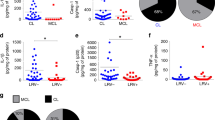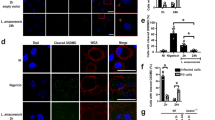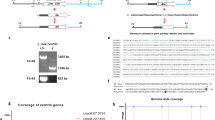Abstract
Leishmania are ancient eukaryotes that have retained the exosome pathway through evolution. Leishmania RNA virus 1 (LRV1)-infected Leishmania species are associated with a particularly aggressive mucocutaneous disease triggered in response to the double-stranded RNA (dsRNA) virus. However, it is unclear how LRV1 is exposed to the mammalian host cells. In higher eukaryotes, some viruses are known to utilize the host exosome pathway for their formation and cell-to-cell spread. As a result, exosomes derived from infected cells contain viral material or particles. Herein, we investigated whether LRV1 exploits the Leishmania exosome pathway to reach the extracellular environment. Biochemical and electron microscopy analyses of exosomes derived from LRV1-infected Leishmania revealed that most dsRNA LRV1 co-fractionated with exosomes, and that a portion of viral particles was surrounded by these vesicles. Transfer assays of LRV1-containing exosome preparations showed that a significant amount of parasites were rapidly and transiently infected by LRV1. Remarkably, these freshly infected parasites generated more severe lesions in mice than non-infected ones. Moreover, mice co-infected with parasites and LRV1-containing exosomes also developed a more severe disease. Overall, this work provides evidence that Leishmania exosomes function as viral envelopes, thereby facilitating LRV1 transmission and increasing infectivity in the mammalian host.
This is a preview of subscription content, access via your institution
Access options
Access Nature and 54 other Nature Portfolio journals
Get Nature+, our best-value online-access subscription
$29.99 / 30 days
cancel any time
Subscribe to this journal
Receive 12 digital issues and online access to articles
$119.00 per year
only $9.92 per issue
Buy this article
- Purchase on Springer Link
- Instant access to full article PDF
Prices may be subject to local taxes which are calculated during checkout






Similar content being viewed by others
Data availability
The data that support the findings of this study are all reported in this paper and are available upon request. All data files containing proteomic analysis are provided in the Supplementary Information with protein names, accession numbers and statistical analysis.
Change history
26 February 2019
An amendment to this paper has been published and can be accessed via a link at the top of the paper.
References
Pigott, D. M. et al. Global distribution maps of the leishmaniases. Elife 3, e02851 (2014).
Martinez, J. E., Valderrama, L., Gama, V., Leiby, D. A. & Saravia, N. G. Clonal diversity in the expression and stability of the metastatic capability of Leishmania guyanensis in the golden hamster. J. Parasitol. 86, 792–799 (2000).
Hartley, M. A., Ronet, C., Zangger, H., Beverley, S. M. & Fasel, N. Leishmania RNA virus: when the host pays the toll. Front. Cell. Infect. Microbiol. 2, 99 (2012).
Janssen, M. E. et al. Three-dimensional structure of a protozoal double-stranded RNA virus that infects the enteric pathogen Giardia lamblia. J. Virol. 89, 1182–1194 (2015).
Widmer, G., Comeau, A. M., Furlong, D. B., Wirth, D. F. & Patterson, J. L. Characterization of a RNA virus from the parasite Leishmania. Proc. Natl Acad. Sci. USA 86, 5979–5982 (1989).
Stuart, K. D., Weeks, R., Guilbride, L. & Myler, P. J. Molecular organization of Leishmania RNA virus 1. Proc. Natl Acad. Sci. USA 89, 8596–8600 (1992).
Widmer, G. & Dooley, S. Phylogenetic analysis of Leishmania RNA virus and Leishmania suggests ancient virus–parasite association. Nucleic Acids Res. 23, 2300–2304 (1995).
Ives, A. et al. Leishmania RNA virus controls the severity of mucocutaneous leishmaniasis. Science 331, 775–778 (2011).
Olivier, M. Host–pathogen interaction: culprit within a culprit. Nature 471, 173–174 (2011).
Alenquer, M. & Amorim, M. J. Exosome biogenesis, regulation, and function in viral infection. Viruses 7, 5066–5083 (2015).
Chahar, H. S., Bao, X. & Casola, A. Exosomes and their role in the life cycle and pathogenesis of RNA viruses. Viruses 7, 3204–3225 (2015).
Schwab, A. et al. Extracellular vesicles from infected cells: potential for direct pathogenesis. Front. Microbiol. 6, 1132 (2015).
Ramakrishnaiah, V. et al. Exosome-mediated transmission of hepatitis C virus between human hepatoma Huh7.5 cells. Proc. Natl Acad. Sci. USA 110, 13109–13113 (2013).
Feng, Z. et al. A pathogenic picornavirus acquires an envelope by hijacking cellular membranes. Nature 496, 367–371 (2013).
Atayde, V. D. et al. Exosome secretion by the parasitic protozoan Leishmania within the sand fly midgut. Cell Rep. 13, 957–967 (2015).
Atayde, V. D. et al. Leishmania exosomes and other virulence factors: impact on innate immune response and macrophage functions. Cell. Immunol. 309, 7–18 (2016).
Hassani, K., Antoniak, E., Jardim, A. & Olivier, M. Temperature-induced protein secretion by Leishmania mexicana modulates macrophage signalling and function. PLoS ONE 6, e18724 (2011).
Silverman, J. M. et al. An exosome-based secretion pathway is responsible for protein export from Leishmania and communication with macrophages. J. Cell Sci. 123, 842–852 (2010).
Ishihama, Y. et al. Exponentially modified protein abundance index (emPAI) for estimation of absolute protein amount in proteomics by the number of sequenced peptides per protein. Mol. Cell. Proteomics 4, 1265–1272 (2005).
Masvidal, L., Hulea, L., Furic, L., Topisirovic, I. & Larsson, O. mTOR-sensitive translation: cleared fog reveals more trees. RNA Biol. 14, 1299–1305 (2017).
Bourreau, E. et al. Presence of Leishmania RNA virus 1 in Leishmania guyanensis increases the risk of first-line treatment failure and symptomatic relapse. J. Infect. Dis. 213, 105–111 (2016).
Dreux, M. et al. Short-range exosomal transfer of viral RNA from infected cells to plasmacytoid dendritic cells triggers innate immunity. Cell Host Microbe 12, 558–570 (2012).
Meckes, D. G. Jr & Raab-Traub, N. Microvesicles and viral infection. J. Virol. 85, 12844–12854 (2011).
Llanes, A., Restrepo, C. M., Del Vecchio, G., Anguizola, F. J. & Lleonart, R. The genome of Leishmania panamensis: insights into genomics of the L. (Viannia) subgenus. Sci. Rep. 5, 8550 (2015).
Peacock, C. S. et al. Comparative genomic analysis of three Leishmania species that cause diverse human disease. Nat. Genet. 39, 839–847 (2007).
Dawar, F. U., Tu, J., Khattak, M. N., Mei, J. & Lin, L. Cyclophilin A: a key factor in virus replication and potential target for anti-viral therapy. Curr. Issues Mol. Biol. 21, 1–20 (2017).
Khan, M., Syed, G. H., Kim, S. J. & Siddiqui, A. Mitochondrial dynamics and viral infections: a close nexus. Biochim. Biophys. Acta 1853, 2822–2833 (2015).
Sugiura, A., McLelland, G. L., Fon, E. A. & McBride, H. M. A new pathway for mitochondrial quality control: mitochondrial-derived vesicles. EMBO J. 33, 2142–2156 (2014).
Armstrong, T. C., Keenan, M. C., Widmer, G. & Patterson, J. L. Successful transient introduction of Leishmania RNA virus into a virally infected and an uninfected strain of Leishmania. Proc. Natl Acad. Sci. USA 90, 1736–1740 (1993).
Walsh, D. & Mohr, I. Viral subversion of the host protein synthesis machinery. Nat. Rev. Microbiol. 9, 860–875 (2011).
Lainson, R., Shaw, J. J., Ready, P. D., Miles, M. A. & Povoa, M. Leishmaniasis in Brazil: XVI. Isolation and identification of Leishmania species from sandflies, wild mammals and man in north Para State, with particular reference to L. braziliensis guyanensis causative agent of “pian-bois”. Trans. R. Soc. Trop. Med. Hyg. 75, 530–536 (1981).
Petersen, T. N., Brunak, S., von Heijne, G. & Nielsen, H. SignalP 4.0: discriminating signal peptides from transmembrane regions. Nat. Methods 8, 785–786 (2011).
Bendtsen, J. D., Jensen, L. J., Blom, N., Von Heijne, G. & Brunak, S. Feature-based prediction of non-classical and leaderless protein secretion. Protein Eng. Des. Sel. 17, 349–356 (2004).
Acknowledgements
This work is supported by grants from the Canadian Institute of Health Research to M.O. A.d.S.L.F. is a recipient of a Brazilian CNPq Science without Borders studentship award.
Author information
Authors and Affiliations
Contributions
M.O. designed and supervised the study. V.D.A. contributed to the development and the design of the study. V.D.A. performed all experiments. M.O., C.M. A.d.S.L.F. and V.D.A. analysed data. A.Z., V.C. and M.J. performed and analysed data from polysome experiments. A.d.S.L.F. and C.M. contributed to the organization of proteomic data files and submission of the manuscript. All authors read and approved the final manuscript.
Corresponding author
Ethics declarations
Competing interests
The authors declare no competing interests.
Additional information
Publisher’s note: Springer Nature remains neutral with regard to jurisdictional claims in published maps and institutional affiliations.
Supplementary information
Supplementary Information
Supplementary Notes, Supplementary References, Supplementary Figures 1–9, Supplementary Tables 1–6, Raw Image Figs. 1–5, and Raw Image Supplementary Figures 1, 7 and 8.
Dataset 1
Total spectra of Leishmania exosomes using Leishmania braziliensis database.
Dataset 2
EmPAI values and ANOVA analysis of Leishmania exosomes using Leishmania braziliensis database.
Dataset 3
Total protein spectra of Leishmania promastigotes using Leishmania braziliensis database.
Dataset 4
EmPAI values and ANOVA analysis of Leishmania promastigotes using Leishmania braziliensis database.
Dataset 5
Total spectra of Leishmania exosome versus promastigote.
Dataset 6
EmPAI values and ANOVA analysis of Leishmania exosome versus promastigote.
Dataset 7
EmPAI values of Leishmania mexicana exosomes and promastigotes using Leishmania mexicana database.
Rights and permissions
About this article
Cite this article
Atayde, V.D., da Silva Lira Filho, A., Chaparro, V. et al. Exploitation of the Leishmania exosomal pathway by Leishmania RNA virus 1. Nat Microbiol 4, 714–723 (2019). https://doi.org/10.1038/s41564-018-0352-y
Received:
Accepted:
Published:
Issue Date:
DOI: https://doi.org/10.1038/s41564-018-0352-y
This article is cited by
-
Evolution of RNA viruses in trypanosomatids: new insights from the analysis of Sauroleishmania
Parasitology Research (2023)
-
Diversity of RNA viruses in the cosmopolitan monoxenous trypanosomatid Leptomonas pyrrhocoris
BMC Biology (2023)
-
Milk exosomes elicit a potent anti-viral activity against dengue virus
Journal of Nanobiotechnology (2022)
-
Transcriptional profiling of macrophages reveals distinct parasite stage-driven signatures during early infection by Leishmania donovani
Scientific Reports (2022)
-
Insights from Leishmania (Viannia) guyanensis in vitro behavior and intercellular communication
Parasites & Vectors (2021)



